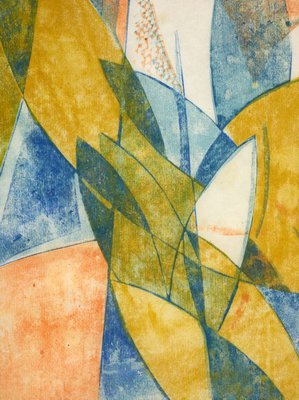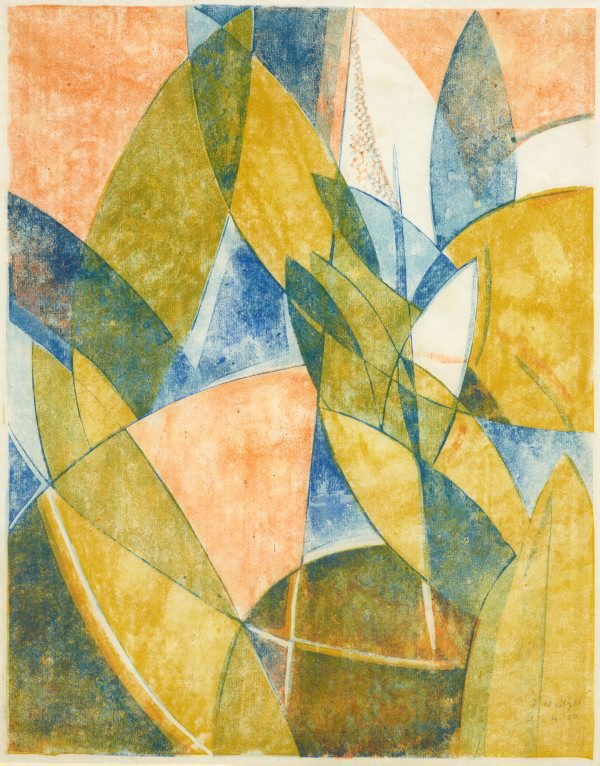

-
Details
- Date
- circa 1932
- Media category
- Materials used
- colour linocut on thin ivory tissue
- Edition
- 4/50
- Dimensions
- 29.0 x 22.5 cm blockmark; 36.0 x 29.0 cm sheet (irreg.)
- Signature & date
Signed l.r. corner in image, pencil "F Weitzel".
- Credit
- Purchased with funds provided by the Australian Prints, Drawings and Watercolours Collection Benefactors 2015
- Location
- Not on display
- Accession number
- 235.2015
- Copyright
- Artist information
-
Frank Weitzel
Works in the collection
- Share
-
-
About
Frank Weitzel was born in New Zealand to a politically radical, German family who emigrated to San Francisco in 1921 when he was sixteen years old. In 1923 he won a scholarship that allowed him to spend three years studying at the California School of Fine Arts, San Francisco, the Art Students League, New York (1926) and the Munich Academy in Germany (1927). He settled in Sydney in 1928 and quickly gained a reputation with the local avant garde for his sculpture, linocuts and textile and furniture design.
Described as “…perhaps Sydney’s most significant modernist sculptor” (Deborah Edwards, ‘Sydney moderns’ AGNSW, 2013 p.164), Weitzel’s short time in Sydney nonetheless had a disproportionate influence on the development of local modernism. Shortly after arriving here he took a studio near Circular Quay, making a number of strongly graphic linocuts of urban Sydney subjects such as the Harbour Bridge, inner city streets and slums. He is thought to have shared a studio with Roland Wakelin (exhibiting a portrait sculpture of him in 1929), showed with the Society of Artists (1928-31), the Contemporary Group and in the inaugural Group of Seven exhibition at Macquarie Galleries in 1930. He designed a ‘Man’s study’ room for the 1929 Burdekin House exhibition, and was ‘warmly supported’ by Dorrit Black who possibly introduced him to Claude Flight, holding a memorial exhibition of his work at her Modern Art Centre, Sydney in June 1933.
By 1930 he was living in Britain, exhibiting with colour linocut artist Claude Flight and other leading modernists including Jacob Epstein, Duncan Grant, and Paul and John Nash. He received critical attention from Roger Fry and was associated with the Bloomsbury set, including writer David Garnett. Weitzel’s untimely death cut short a promising career that had already produced exceptional work and a small but significant legacy for Australian modernism.
Weitzel was a cosmopolitan and eclectic artist, capturing the modern spirit of the world in his art and design, international interests and outlook. The influences on his work were extensive – from Art Deco and Bauhaus, through primitivism and modernism, German expressionism and the colour linocuts of Claude Flight and the Grosvenor school.
Weitzel’s prints featured in two exhibitions organised by Flight at the Redfern Gallery in 1930 and 1931 and it was Flight’s influence that led Weitzel to extend his printmaking practice into multiple-block colour printing. This print was made in Britain and reveals strong futurist and cubist influences; Flight wrote to Dorrit Black on 11 June 1930; “I am very pleased to have Mr Weitzel’s work for the show. I like it very much, it is original, strong, good of its kind & just the sort of work we want.” (quoted in Stephen Coppel ‘Claude Flight and his followers, the colour linocut movement between the wars’ Australian National Gallery, Canberra,1992 p. 17).
-
Exhibition history
Shown in 3 exhibitions
Exhibition of the latest work of Frank Weitzel, Modern Art Centre, , 07 Jun 1933 -
Modern impressions; Australian prints from the collection, Art Gallery of New South Wales, Sydney, 02 Sep 2016–Jan 2017
20th-Century galleries, ground level (rehang), Art Gallery of New South Wales, Sydney, 20 Aug 2022–2023
-
Bibliography
Referenced in 5 publications
-
Bonhams Australia, Bonhams Australia: Important Australian and international art including private collections curated by John Cruthers, Tuesday 16 June 2015, Sydney, Sydney, Jun 2015, 108, 109 (colour illus.). Image for AGNSW work is lot no. 61 on pg. 108. Text that applies to this work is text for lot no. 60. The images have been incorrectly titled by Bonhams.
-
Roger Arthur Butler and Chris Deutscher, A survey of Australian relief prints 1900/1950, Armadale, 1978, 96 (illus.). Cat. 191 (Abstract), another impression
-
Gail Ross, Art New Zealand, 'A sullen silence: Frank Weitzel, modernist (1905-1932)', pg. 88- 91, 107., New Zealand, Spring 2005, 88 (colour illus.), 89, 91. another impression
-
"Trilby", The Art Student, 'The modern art centre' in 'News and notes', pg.16, Melbourne, Jun 1932, 16.
-
Christie's Australia: Australian, international and contemporary paintings, Sydney 23 & 24 August 2004, Melbourne, 2004, 161 (colour illus.). Lot no. 212 [mistitled] Abstract design no. 2
-




